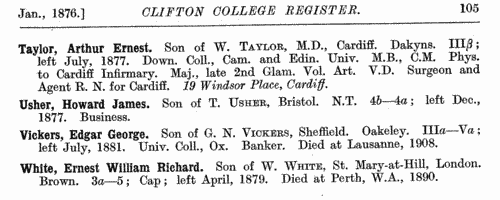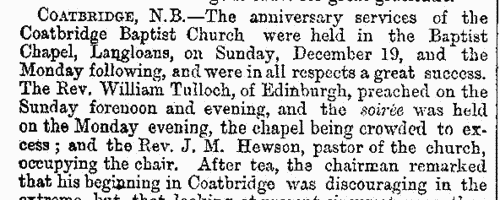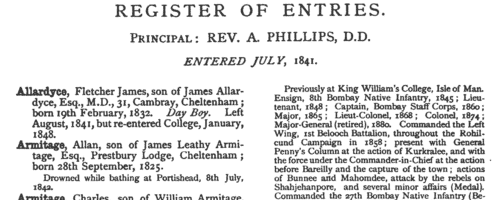Add this eBook to your basket to receive access to all 166 records. Our indexes include entries for the spelling piers. In the period you have requested, we have the following 166 records (displaying 141 to 150): These sample scans are from the original record. You will get scans of the full pages or articles where the surname you searched for has been found. Your web browser may prevent the sample windows from opening; in this case please change your browser settings to allow pop-up windows from this site. Boys entering Clifton College
(1871)
Clifton College near Bristol was established in 1862. This edition of the Clifton College Annals and Register for the Old Cliftonian Society by F. Borwick was published in 1925. Boys are listed alphabetically by term of entry, with full names, surname first, in bold. Father's (or widowed mother's) name is given (surname and initials) in capitals, and address. Then there is the name of the house (N. T., North Town; S. H., School House; S. T., South Town), first and last forms, distinctions in school work and games, and month of leaving. Where known, the editor then gave a career summary with month of death; or, if still living, address as in 1925 (in italics). | Sample scan, click to enlarge

| Baptists
(1876)
The Baptist was a weekly newspaper, with some general news and political coverage, but mainly devoted to chronicling Denominational Intelligence, i. e. the doings of the Baptist churches in Britain and Ireland. January to June 1876. | Sample scan, click to enlarge

| Voters in Macclesfield: South-West Ward
(1879-1880)
The electoral register for 1879-1880, for part of Macclesfield, in Cheshire. | Sample scan, click to enlarge

| Boys entering Cheltenham College
(1880)
Cheltenham College 'was founded in order to provide for the sons of gentlemen a Classical, Mathematical, and General Education of the highest order, on moderate terms, in strict conformity with the principles and doctrines of the Church of England.'
Andrew Alexander Hunter, the college registrar, compiled the first edition of the College Register in four parts from 1883 to 1886: these merely listed the boys by term of entry, with their dates of birth and names and addresses of their fathers. Circulars were also sent out to all Old Cheltonians whose addresses were known, requesting additional details. On the basis of the returns from these and Hunter's further researches, this much fuller register was published in 1890.
The information after each boy's name is given (where known and applicable) in this format: father's full name and address as of the time the boy entered the college; class and department on entering the college (classes being number from 1 downwards, and these again divided into A and B, some into C and D, others into P (Principal's side) and V. P. (Vice-Principal's side) - 1A was the highest class in each department: besides this, certain others were called Addiscombe, Woolwich, Civil, Direct, Line, Sandhurst, Naval, Special, Preparatory, Latin, and India Civil) and the same on leaving, name of Boarding House (or 'Day Boy'), scholastic and athletic honours attained at the college, and subsequent career (including date and place of death, or present address in 1890, if known). | Sample scan, click to enlarge

| Missing Next-of-Kin and Heirs-at-Law
(1880)
The Unclaimed Money Registry and Next-of-Kin Advertisement Office of F. H. Dougal & Co., on the Strand in London, published a comprehensive 'Index to Advertisements for Next of Kin, Heirs at Law, Legatees, &c., &c., who have been Advertised for to Claim Money and Property in Great Britain and all Parts of the World; also Annuitants, Shareholders, Intestates, Testators, Missing Friends, Creditors or their Representatives, Claimants, Unclaimed and Reclaimed Dividends and Stock, Citations, Administrations, Rewards for Certificates, Wills, Advertisements, &c., Claims, Unclaimed Balances, Packages, Addresses, Parish Clerks' Notices, Foreign Intestates, &c., &c.' The original list was compiled about 1860, but from materials dating back even into the 18th century: most of the references belong to 1850 to 1880. For each entry only a name is given, sometimes with a placename added in brackets: there may be a reference number, but there is no key by which the original advertisement may be traced. The enquirer of the time had to remit £1 for a 'Full and Authentic Copy of the Original Advertisement, together with name and date of newspaper in which the same appeared'. | Sample scan, click to enlarge

| Debtors
(1881)
County Court Judgments in England and Wales | Sample scan, click to enlarge

| Partnerships Dissolved
(1882)
Dissolution of trading partnerships, or removal of a partner from a business, in England and Wales | Sample scan, click to enlarge

| Creditors under 22 & 23 Vict. c. 35
(1883-1884)
Volume 76 of The Law Times, 'The Journal of The Law and The Lawyers', a weekly publication, runs from 3 November 1883 to 26 April 1884. Much of the journal is taken up with law reports, leading articles, &c., and the 'Solicitors' Department' contains several regular features of great interest, including 'Creditors under 22 & 23 Vict. c. 35'. That was a piece of legislation introduced to protect executors and administrators from litigation (whether from kin or from creditors) after the assets of the deceased had been distributed, by allowing the publication of notices stipulating a Last Day of Claim, absolving the estate from later demands. These lists are therefore effectively those of the recently deceased whose affairs were in the process of being wound up; the index covers both the deceased and their solicitors. | Sample scan, click to enlarge

| Bankrupts
(1884)
In accordance with the Bankruptcy Act of 1883, notices received by the Board of Trade were gazetted in tabular form by the Inspector-General in Bankruptcy. At each stage the record gives the debtor's name, address (often including former addresses), description (i. e., occupation), the name of the court, and the sequential number of the matter in that court for the year. The tables of Receiving Orders additionally give Date of Order, Date of Petition and Date of Public Examination; notices of First Meeting give Date of Meeting, Hour and Place; Adjudications give Date of Order, Date of Petition, Name of Trustee (if appointed) and Address of Trustee; Notices of Intended Dividend give Last Day for Receiving Proofs, Name of Trustee, and Address; Notices of Dividends give Amount per Pound, When Payable, and Where Payable; Applications for Debtor's Discharge state the Day fixed for Hearing; and notices of Appointment of Trustees give the Trustee's Name, Address, and Date of Certificate of Appointment. Any one debtor would normally appear in a number of these tables as his or her case proceeded over the months. These are the notices gazetted in 1884.
| Sample scan, click to enlarge

| Debtors
(1886)
County Court Judgments in England and Wales. April to June 1886 | Sample scan, click to enlarge

|
Research your ancestry, family history, genealogy and one-name study by direct access to original records and archives indexed by surname.
|











